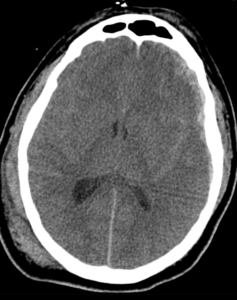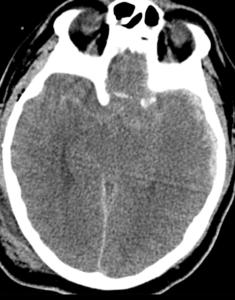A late 20s male presents with LOC after motorcycle accident without wearing a helmet.
HPI: Bystanders found the patient prone and unconscious. He was brought by EMS to a Level 1 hospital intubated and GCS 3T. No additional medical history is available, no family members are present.
Vitals: He was bradycardic, with his lowest heart rate recorded at 28 bpm, and hypertensive with an initial blood pressure of 172/118 mmHg and markedly elevated blood pressure of 221/105 mm Hg 30 min at the time of arrival to the facility.
Physical Exam: GCS 3T, 4mm bilaterally fixed pupils, negative corneal response, right parietal cephalohematoma, and cerebral spinal fluid (CSF) otorrhea on the right.
Imaging: CT of the head (see figures) showed subarachnoid hemorrhage with left frontal and temporal subdural hemorrhage, effacement of the suprasellar cistern, and effacement of the 3rd and 4th ventricles. In addition, CT studies showed a left frontal/temporal and parietal hematoma with mass effect and cerebral edema causing a 5.38-mm left to right midline shift



Room 9 Treatment: He required atropine push and nicardipine infusion (blood pressure was allowed to remain elevated to ensure continued brain perfusion for a target of SBP ~ 180. An arterial line, central venous catheter, and external ventricular drain were placed for fluid and medication administration and ICP management while the OR was prepped. Emergent treatment for herniation syndrome included endotracheal intubation with mild hyperventilation, 30 grams of IV Mannitol, HOB at 30 degrees, and EVD. Longer term treatment options include hypertonic solution of 23% (weight/volume) sodium chloride (NaCl) and after room 9 measures left-sided decompressive craniectomy.
Clinical course: Postoperatively, an external ventricular drain (EVD) was placed; the initial intracranial pressure (ICP) was 14 mmHg. The patient was examined postoperatively and his GCS was 5T, with bilaterally reactive pupils, and positive corneal reflex in the left eye. CT of his head showed improvement of midline shift and the ventriculostomy catheter tip was found to be in the proper location in the frontal horn of the right lateral ventricle The patient was then started on 3% NaCl continuous infusion. ICP and cerebral perfusion pressure (CPP) displayed normal values at 3–4 and 70–75 mm Hg, respectively, for the first 24 h with the EVD open at 10 cm H2O.
His clinical course was complicated by VAP requiring antibiotics and bronchoscopy, later developing C Diff infection. He underwent tracheostomy and g-tube placement. His GCS examination improved to 10T, for which he was started on a neurostimulator drug amantadine. Ultimately, the patient was discharged to rehab.
A follow-up visit three months later revealed the patient was living at home with his mother. In the interim, his tracheostomy and gastrostomy tube had been removed. His major neurologic sequelae were transcortical motor aphasia and mood disorder. His GCS was 13 (E4, V3, M6). Ultimately his craniectomy defect was corrected surgically with a bone flap.
Teaching Points: When predicting mortality and unfavorable outcome following TBI, exam, laboratory, and imaging findings can be used together by utilizing the CRASH and IMPACT calculators. An unfavorable outcome is described as death, vegetative state, or severe disability. Here, we describe a patient who presented with a GCS of 3, bilaterally fixed pupils, and CT findings of subarachnoid bleeding, midline shift, subdural hematoma, effaced 3rd ventricle, effaced 4th ventricle, and effaced basal cisterns. Therefore, according to the CRASH calculator, which takes into account country, age, GCS, pupil reactivity, and CT findings, he had a 14-day mortality risk of 91.8% and a 95.7% chance of unfavorable outcome at 6 months
His pertinent laboratory studies, which are utilized along with exam and imaging findings in the IMPACT calculator, revealed an initial glucose concentration of 260 mg/dL and a hemoglobin concentration of 15.4 g/dL. Using the IMPACT calculator, at 6 months, the patient’s predicted probability of mortality was 62% and the probability of an unfavorable outcome was 77%.
He left our facility bedbound, ventilator- and tube feed-dependent, and in a minimally conscious state with a GCS 10T. Yet despite all this, he had a favorable recovery. Within 1 year of discharge, he was able to live at home, interact, and go shopping with his mother, walk, feed himself, and perform simple chores and ADLs
This is a poignant reminder that the variability between individual patients makes prognosticating after traumatic brain injury difficult and uncertain. This case shows that severe caution should be taken when using prior studies to make medical decisions about individual patients. Treatment of traumatic brain injuries is complex and should continue to evolve with evidence-based medicine. Improvement in outcome is not based on 1 intervention; rather, it is the additive effect of multiple interventions. In addition, the initial EMS response and ER Room 9 interventions along with later daily multidisciplinary rounds with Neurocritical Care, Trauma Critical Care, Infectious Disease, Pharmacy, Respiratory Therapy, Physical Therapy, Occupational Therapy, Social Services, Chaplain Services, and Dietary Services provided optimal medical management in a team-based approach.
![Room9er ["Room Niner"]:](https://room9er.com/wp-content/uploads/2020/03/cropped-Screen-Shot-2020-03-08-at-3.16.16-PM.png)